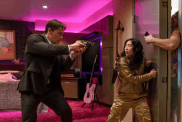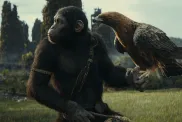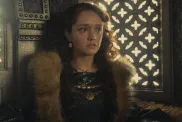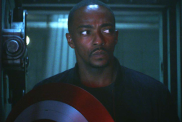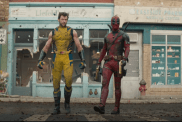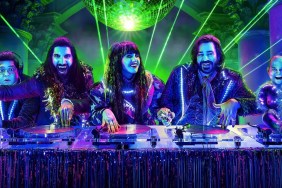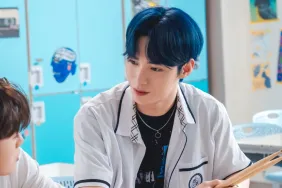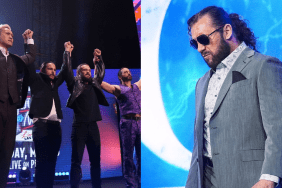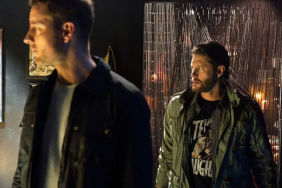Tatopoulos, McQuaide preview Lycan uprising

When a seasoned special effects artist makes the leap from his, or her, day-to-day shop duties and into the director’s chair, it’s always attention-worthy. Not just for the visuals they’re bound to deliver on but to see how well they can execute the human element in between the gags. Is there an accomplished storyteller lurking beneath the visionary or are they simply skilled with illusions made of latex and foam? Results in the past have run across the board, from great (Stan Winston’s Pumpkinhead), to fair (Tom Savini’s Night of the Living Dead), to piss-poor (Kevin Yagher, er, Alan Smithee’s Hellraiser: Bloodline) to bizarre (Steve Wang and Screaming Mad George’s The Guyver). The latest “man behind the movie monsters” to take on a feature is Patrick Tatopoulos whose creations have rampaged through Pitch Black, Godzilla and Silent Hill.
His directorial debut? Underworld: Rise of the Lycans, the third chapter in Screen Gems’ lucrative franchise that takes fans back to the beginning and retraces the events that kicked off a blood feud between the vampires (led by Bill Nighy) and the Lycans (Michael Sheen leads the werewolf revolt) – the violent backdrop for Len Wiseman’s Underworld and Underworld: Evolution, starring Kate Beckinsale and Scott Speedman.
The first two entries undeniably bore Shakespearean themes amongst the gunplay and creature-on-creature beat-downs. Here, Tatopoulos says, Lycans is very much in line with Sparticus and, again like the first film, “Romeo & Juliet” in that it tells the forbidden love story between Lucian (Sheen) and Sonja (as played by newcomer to the series Rhona Mitra). But make no mistake, you’ll be getting gobs of monster mayhem. This is an FX vet at the helm, after all.
At Luma Pictures – a visual effects house nestled in Venice, California – ShockTillYouDrop.com is granted an early look at the film with Tatopoulos and executive producer/visual effects supervisor James McQuaide on hand to guide us through a few scenes. In a conference room surrounded by heads of Lycans sitting on tables like snarling trophies, we witnessed two scenes.
The first was a werewolf attack on a horse drawn carriage party led by a shackled Lucian and Raze (Kevin Grevioux), Sonja and a number of vampire soldiers. The assault begins from the ground when two hairy, clawed hands burst from the ground, take hold of a horse’s legs and pull the animal down. Multitudes of werewolves – looking much like “William” from Evolution except appearing black rather than whitish-gray – appear from all sides and a sword and claw combat ensues. Werewolves are cut down, severed in two, decapitated and the vampires suffer some casualties. What’s worth noting, aside from the generous amounts of bloodshed (perhaps more than we’ve ever seen in these films), is that the werewolves used tunnels beneath the ground to attack their prey and this lends itself to a few great visuals. When the first attack wave ends, more beasts come out of hiding and just when it’s looking grim for those left standing, Lucian transforms into his Lycan self; this seems to puzzle and hold the werewolves at bay, temporarily.
Scene two is a classic “siege” sequence that finds Lycans and werewolves (you’ll understand the difference in the interview below) charging Viktor’s (that’s Nighy) castle, running on all fours, some transforming, others being skewered like shish-kebobs by giant arrows being fired from the castle’s parapet. They claw their way up the walls and invade the fortress tearing into any armored vampire that gets in their way. This is the most Lycan action we’ve ever seen in an Underworld film and it’s a goddamn bloodbath. It’s the type of ambition and madness one would expect to see from a man with the background Tatopoulos has. Pretty exciting stuff. Now we wonder if he bites into the drama of the film with as much vigor…

Following this presentation, Tatopoulos and McQuaide addressed a number of questions about the prequel’s genesis, story, scale, design process and cast members…
ShockTillYouDrop.com: You’re being entrusted to tell this epic prequel story that, until now, was only glimpsed at in the pages of a book Selene flips through in the first Underworld, so how did you convince Sony that you – a newbie director – were the guy for the job?
Patrick Tatopoulos: It was actually offered to me. They came to me and said, hey, it’s a logical choice. You’ve worked on the first two movies, we’ve known each other for a while and we think you have the eye and what it takes to do it. When I read the script and found it was more about werewolves than anything else, I got really excited about it. It’s more of my stuff. [In terms of “epic”] I didn’t think so much Lord of the Rings, this is more like Gangs of New York, my version of that with werewolves. It’s smaller with clans fighting each other. The scale, although it gets big at the end, there’s 300 werewolves against 300 vampires. I didn’t want the scale to feel ridiculous. The key thing for me, when [the studio] talked to me, was to do something a little more different than the first two films. I was excited because it was to retain the style but do something a little fresh and new.
Shock: The previous two entries pride themselves on a healthy balance of practical and CG effects to create the world, with a lot of importance being thrust on the practical side. Is that the case here or did you sway more in either direction?
Tatopoulos: On the first two movies, when you see the werewolves, you see two or three of them at a time. It’s more about the vampires and wolves in the human form so you don’t see many big epic moments. I was forced to go more CGI here because there’s no way I could bring 300 people in suits running. By essence, I knew I’d be doing more CGI stuff. Obviously, every time we could, more practical would come into play. Interestingly enough, I only had one mechanical werewolf head to play with, when you have 300 in a courtyard to play with it’s difficult to do with only one head. And there were three other [practical] werewolves with no mechanical heads which quickly looks stupid. For a brief moment you can get away with it. What they helped me for was lighting reference not only just to maybe replace them [with CG] but to also add other ones around.
James McQuaide: There were 29 CG werewolf shots in Underworld: Evolution and there are 80 in this movie. Beyond just the army of werewolves at the end, throughout the picture, there are quite a few single and double werewolf shots. The industry just moved. On the first picture, CG creatures – not many companies were doing that work – now it’s commonplace, more so than it was seven years ago and the film reflects that decision.
Shock: What was the decision making process behind wanting to do a prequel instead of a sequel?
McQuaide: I think a lot of it was what Len [Wiseman] brought to the table. He’s the godfather of all of these movies and this is where he thought these movies should go. In this direction. So we took his lead and obviously Screen Gems agreed.
Tatopoulos: When we did the first film, like everything else, you have to create a backstory before you make the movie. This story was part of the first film to establish what was happening and Len always liked it. In some ways this closes the chapter of Underworld and now, whatever they do next, I don’t know, they could be going back to the future. But it felt like the right time to do this.
McQuaide: After seeing this movie, because of the way it’s structured and it’s so much about the backstory, you almost want to go back and re-watch [parts] one and two because all of that backstory that’s implied in the genetic memories and dialogue [in the first two films] you now see it so it all makes sense. It almost builds excitement for the other two films.

Shock: Well, story-wise, one might say that they’ve seen the first film and have seen the flashbacks and know all they need about the story you’re telling. So what more does this tale have to offer?
Tatopoulos: You’re seeing the struggle of a man, Lucian, the original Lycan, who’s being used to create a race of Lycans. He knows he’s created a race, he’s responsible for this. That’s why we keep calling it Sparticus. Someone, as a kid, is being pushed to do something he doesn’t want to do and he’s tormented his entire life for it and he happens to fall in love with a vampire, which doesn’t help. But his main thing in life is to take his people, that he’s created and have been tortured and enslaved all his life…he has to take them away from that place. That’s the main driving thing. To me, what I’ve seen from the last two movies, is a sequence of a girl, [Sonja], dying and that’s it. When I saw the first movie, I was interested in seeing more. I’m hoping you’ll go into this not completely knowing how it will end. There’s an element you will recognize, but the journey is not a straight line. It’s more what makes people get to this point and I hope there will be some surprises.
Shock: Michael Sheen was on the slab in the second entry, now he’s alive and in prime form. How excited was he to come back and did it take him some time to find his character Lucian again?
Tatopoulos: For me, I thought Michael’s done The Queen and Frost/Nixon, all of these kick-ass movies. This is going to be a flick for fun. He got so involved in the movie. I found that I just had to let him go to become the character. When I let him breath, he felt comfortable and was extremely passionate. His character in the first Underworld is a man 300 or 400 years after the events [in Lycans]. He’s living in a modern time. We see Lucian as a kid and the character he is here is very different from the first Underworld. You see him becoming the man in charge. Here he’s a man suffering and he had to go deeper into his origins.
Shock: Can you talk about landing Rhona?
Tatopoulos: That was the choice of the studio in the first place. I thought she was a great choice because there’s a clear sentence in the first Underworld, I think, where [Viktor says], “You remind me so much of my own daughter.” Great. Rhona was a perfect actress for that. She’s different than Kate [Beckinsale], more of the warrior. Kate’s very sophisticated, there’s some quality in Kate you don’t find anywhere else. But Rhona had that warrior, primeval, rough quality that fit the movie because this is more brutal. From the beginning, she was conscious of the fact that she was going to be the next girl – worried she was the new Kate in some way. I said to her, “It’s simple. The character of Selene was created from your character, so don’t try to match it. You’re the origin of everything.” That made her feel good.
Shock: From an effects standpoint, each Underworld film has offered us something new, visually. The first film was introductory, giving us a glimpse at this new world. The second had the Marcus bat creature. What’s on board in this film?
Tatopoulos: I think the world is what’s new. When you watch the whole movie, it’s a new setup, the castle, the period flavor is what’s going to be new. There is no new character to be seen. But in terms of werewolves, you’ll be seeing masses of them which we’ve never seen before. So it’s the amount of them and how they act together. This is the same kind of scale we had on the last two films – the budget – so what I really wanted to do was what Len did: Make a great movie on so little money. To be visual director and make something bigger than what you’ve been given. And I’ve got all the right people around me and the tools to do it.

McQuaide: From a purely technical exercise, we tried to make the transformations a bit better. The guys here [at Luma] did the transformations in the second picture so they’ve taken and built on that. We’ve got guys on fire transforming, guys transforming to and from werewolves, three guys in one shot transforming…we’ve tried to take the techniques from the second film and make them even grander somehow.
Tatopoulos: We shot in New Zealand and I had a team of people who did Xena years ago, so these people know how to do this stuff. They know how to work cheaply and efficiently, then they went on to Lord of the Rings. I’ve got Dan Henneh building the sets. We’re talking about the scale of the movie, it’s not just visual effects, it’s what these people give me in the first place. I had huge sets, not tall because we couldn’t find a place high enough, but we had big, high-end sets. And I’m a production designer, so I can compare that.
Shock: Has the change in weaponry affected how the action is orchestrated? You’re no longer dealing with guns…
Tatopoulos: I was very attentive to that. When you see crossbows and get into it with the sound, they can be like machine guns, with good sound they’re very powerful and classic. They didn’t have the technology at the time, everything that shoots has a machine gun flavor though. There’s a big sequence when the Lycans escape and they’re being shot at with a crossbow and it sounds very different. I didn’t want stuff to sound too period-y. Between that and the music there’s stuff that’s much more modern. You’ve seen the crossbows [in the clip] and they’re huge. For me, it was playing with the sound and creating something that wasn’t appropriate for the time and making them bigger.
Shock: I noticed some of the designs of the werewolves have evolved and there’s a distinct difference between their look and Lucian’s animal side. Why is that?
Tatopoulos: At the beginning, [in the story] there were werewolves, then an aberration happens and the first Lycan is Lucian. By essence there’s a connection and a difference.
Shock: That’s why there’s a change in the facial design.
Tatopoulos: Yes. When Len talked to me about designing the first werewolf on Underworld, I’ve seen a wolf on a human body [before], so I wanted to give them a shorter muzzle which is now what we call a Lycan. Today, when we made this movie, we realized it worked for us because there are two types of werewolves. But my original design was for the werewolf. Now, as the story goes on, this is Lycan, short face. They’re creatures that can change into a beast or human, day or night. They have control of their body. People bitten by werewolves, they can only go back to their human form after death. You’ll see in the movie when that logic is understood.
Shock: How jazzed was actor and co-creator Kevin Grevioux to be back in series?
Tatopoulos: He’s such a cool guy and was always like [on set], “Did I do good today?” He has a much bigger part and there’s very strong moments between him and Michael’s character. He’s passionate about this series and he’s got ideas to do so many of these movies. Great ideas, by the way. I was happy he’s back. He doesn’t talk too much, but he’s got such a presence. And this is an origin story for him, too. We had created a cool make-up for him mid-stage, but we couldn’t do it. He does transform though.

Shock: You didn’t shoot the mid-stage make-up?
Tatopoulos: No, I took pictures and it was cool. But we never shot it.
Shock: Do you see yourself coming back for another Underworld?
Tatopoulos: I’ve done three of them in different capacities but I think I’d like to move on. No disrespect. I think there are still many stories that could be told, it’s a cool franchise, but I’d like to do something new.
Shock: Something outside the genre?
Tatopoulos: I need to do something with creatures and stuff. But there’s a project in the works that I’m keen on doing. When I did this movie I felt I was not controlling the look because there are two films out there and there is a style, although I was part of it and I designed the creatures on the set. But I feel I need to create a world from scratch, something new.
Shock: But there are some people who would look at these films and say this is your look. They’re Len’s movies but they would see the layers and what you designed.
Tatopoulos: That’s nice, but with a guy like Len, some directors are less about design, he’s very much about it. We worked together on the movie. If you wanted to put it another way, I just need to create something completely different. The next film I do is not a period piece. I like films like Dark City where there’s no period attached but it’s a cool world.
Shock: So, is your long-mooted Dracula tale The Last Voyage of the Demeter sunk?
Tatopoulos: I’ve worked so much on that movie and it’s something that’s still floating in the air. It’s a great project, I really want to do it. I don’t know how quickly they are to move, but again, it’s another vampire story.
Underworld: Rise of the Lycans opens in theaters January 23rd.





Source: Ryan Rotten, Managing Editor
